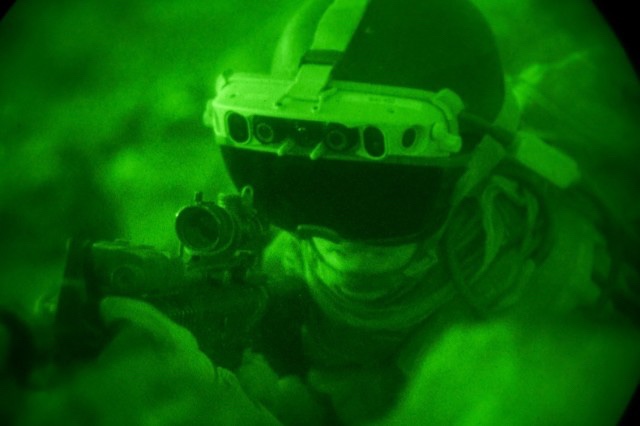
FORT IRWIN, Calif. — The 11th Armored Cavalry Regiment frequently functions as an opposing force, providing a realistic training environment for service members participating in exercises at Fort Irwin’s expansive National Training Center.
Last month, however, select Soldiers from the regiment had the opportunity to serve in a different and very unique role — that of a future warfighter.
Equipped with prototype wearables, next-generation drones and specialized knowledge of maneuver warfare, the Soldiers lent their time and insights to support Project Convergence 22, an experiment designed by the Army to illuminate the benefits and challenges new technologies could bring to tomorrow’s battlefields.
“It’s cool that we’re shaping the future of the Army,” said Sgt. Austin Gazaway.
Gazaway saw value in conducting future force experimentation alongside major allies — an effort he viewed as helping to “open up transparency” about emerging capabilities and warfighting systems.
Sgt. Calvin Robinson also enjoyed taking part in operational scenarios created specifically to field-test new technologies.
“I feel like the PC22 event went really well,” he said. “It was a good opportunity to see what the Army is possibly deciding to give future Soldiers.”
Gazaway, Robinson and other 11th ACR Soldiers, many of whom had not previously participated in dedicated Army innovation efforts, spent seven days in early November assessing the effectiveness of equipment such as the Enhanced Night Vision Goggle – Binocular, or ENVG-B; the Integrated Visual Augmentation System, or IVAS; and the ExoBoot.
“Going from old to new, to high-powered technology, it’s pretty nice,” said Spc. Ian Campbell.
Campbell felt the ENVG-B’s dual scopes performed better than a more traditional single scope night vision goggle.
“I thought it was really helpful to keep track of my team and to see where my guys are,” he said. “I think overall it improved our team’s lethality.”
For many of the Soldiers, using the still-in-development technology took some getting used to. Several experiment participants noted that the IVAS and ExoBoot still had “some kinks” to work through, but that they looked forward to seeing how the Army would incorporate their feedback into future iterations of the apparatuses.
“The fact that they gave us a chance to actually use some of the products is a really good thing, I feel like,” Robinson said.
Robinson added that the 11th ACR’s familiarity with the terrain at the National Training Center, which encompasses more than 1,000 square miles, helped ensure the technology received a rigorous and authentic evaluation.
Following completion of the experiment, the overall consensus among 11th ACR Soldiers interviewed was that the Army’s new approaches to enhancing Soldier Lethality were promising.
“I feel like it will make a lot of stuff easier,” Gazaway said.
He additionally reflected on how Soldiers in the past likely thought certain equipment that the Army uses today was “weird” or awkward when first introduced, but that adjustments to new operating tools and methods are a natural and necessary aspect of change.
“The future just keeps moving forward.”
Campbell agreed.
“At some point, it will just become the new normal.”
By Maureena Thompson, Army Futures Command


I hope they can work out the kinks in IVAS. Despite the struggles, no funding was cut in this NDAA. Might lose some in appropriations later, we’ll see.
It’s a hot mess. There are two additional versions (1.1 & 1.2) still in the works. 1.2 is a complete form factor change.
That umbilical is a PITA and the whole system is heavy. Also, the controller sucks. This I can tell you from personal experience.
There’s also the issues with latency and getting the images to line up.
I’ve been following it as close as I can as a civilian. Formfactor I think can be fixed. 1.2’s supposed to cut the weight to the level of the ENVG-B, switch to a NVG helmet mount and move the umbilical to the rear.
The choice of ski-goggles was odd, but for some reason the Statement Of Objectives mandated no helmet mount. Shame it went this far without a reconsideration if it’s something that was needed.
I’m really worried about the eye strain/latency/image alignment as you said since they may simply be a limitation with AR displays and the disconnect between an AR image and the real world. They can get latency down but there’s optical trickery with how your eyes focus on AR content versus the world and it may be something soldiers get used to (or not, and refuse to use it!)
What’s the issue with the controller/puck?
And one other question, what’s you’re experience with the light security of IVAS? There was a damning FT leak that it was still an issue in IOTE. I’ve got one video showing the eyeglow, but it’s on none of the other soldiers wearing IVAS. I’ve also got a bunch of pictures of IVAS under night vision including from ENVG-B and you can’t see anything.